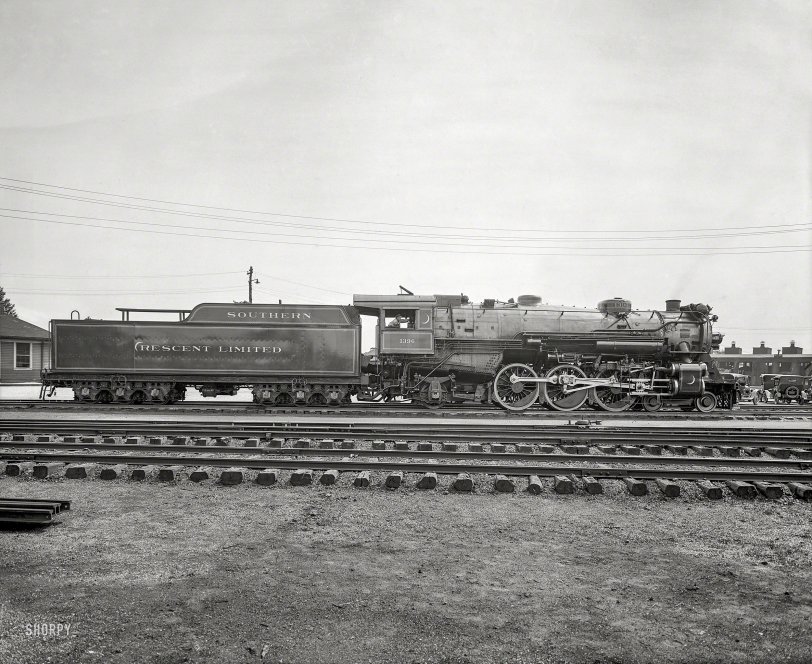


Framed or unframed, desk size to sofa size, printed by us in Arizona and Alabama since 2007. Explore now.
Shorpy is funded by you. Patreon contributors get an ad-free experience.
Learn more.

- Recent view
- Hudson’s Big Store
- Say what??
- Grapes?!
- A Beautiful Moment
- Such joy
- Bethune-Cookman University today...
- Yellow sky at morning
- Side Winder
- Air Quality?
- Sojourner Truth riot
- None were so blind(ed)
- The less famous sister
- Good ol' days?
- Rise and Fall
- Goo Goo Ga Joob
- Ticket Retention
- Not the only one
- Vagaries of War
- Killed by Amtrak
- Back to the Future
- Wanted --
- If you can't stand the light
- Centralized Traffic Control, I believe
- What's really happening
- Heckuva remote control!
- Sometimes — Things Go Bump!
- I SEE THE LIGHT
- Union Switch and Signal Company
- Get That Light Out Of My Eyes
Print Emporium
Motive Power: 1926

"The Crescent Limited, ace of the Southern Railway System's passenger train service between New York, Washington, Atlanta and New Orleans."
Alexandria, Virginia, circa 1926. "Southern R.R. Co. Crescent Limited locomotive." Previously seen here and here. National Photo glass negative. View full size.
And what's more --
The tractive effort used to pull the weight of the locomotive and all those cars is concentrated at just six small points on the rails. Each no larger than a silver dollar.
Maybe Then
'Tractive Effort' could also be compared to Torque in a regular engine, say, gas or diesel. Regardless of nomenclature, a very powerful machine and designed well before computers were there to assist.
Memories
Shorpy does it again! Made me think of my brother and me sleeping on our grandmother's screened-in back porch in a feather bed. This was in the late 40's. The train tracks were about 100 yards away and several times during the night we would wake up to a passenger train just passing through. We could see the lights in the cars and even the people sitting or moving around.
Horsepower
Steam locomotives are unbelievably powerful machines. Though, as DepotHack pointed out, tractive effort (the amount of pulling force a locomotive can deliver to the rail) is the more usual measure of a locomotives strength, if this 1923 design steam locomotive were to be put on a treadmill to measure her horsepower, she would probably measure at a peak approaching 2,000 horsepower at a speed of about 45 mph. By the end of WWII steam locomotives approaching 8,000 hp were being built routinely.
By comparison, the diesel locomotives which replaced steamers in the decade following WWII were generally rated in the range of 1500 to 1750 hp each, which they could produce only up to 18 mph after which their hp curve dropped dramatically. This is why it took, usually, 4 diesels to replace each steam engine on the head of a train.
So, you ask yourself, why were the railroads of that decade of transition so eager to replace steam with diesel power? Answer: Labor and availability. A steam engine (at that time) was cheaper to build, but far more expensive to run.
Power
A more meaningful measure than horsepower would be "tractive effort" and in the case of this beautiful passenger engine, the tractive effort is 47,500 lbs. Pretty impressive for a high speed passenger engine with 73 inch drivers!
6x6 traction
I wonder how many HPs was this machine able to produce.
Sister Engine is at the Smithsonian
The sister engine to this 4-6-2 engine is on display at the Smithsonian. It is numbered No. 1401 and was the engine used to bring FDR's body back to Washington from Warm Springs, GA. See more here.
All I can say, even in 2016, is --
What an awesome piece of machinery, engineering and design, wow.
This locomotive
was painted green, I'm waiting for the coloured version.
Man at the Throttle Pose
From the time they were built, over a period from 1923 to 1926, the Southern Railway's class 4-6-2 Pacific type locomotives have been recognized as among the most beautiful steam locomotives ever. Painted green, with gold lettering and decoration.
Despite the engineer's pose, this engine isn't going anywhere very fast or very soon. It's third drive wheel is chained to the rail.
























On Shorpy:
Today’s Top 5